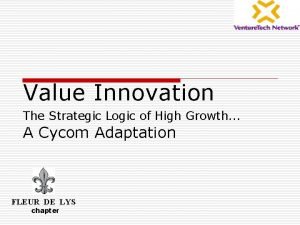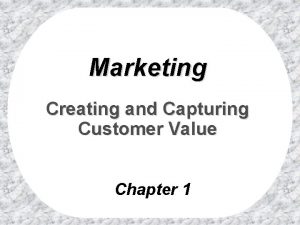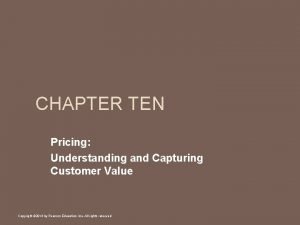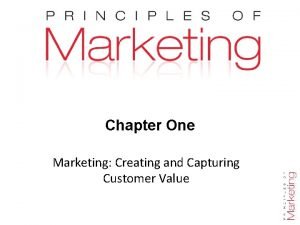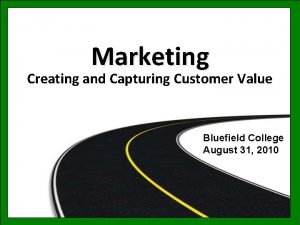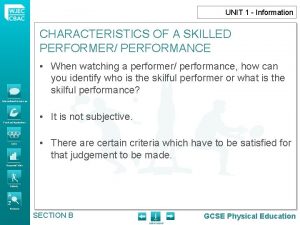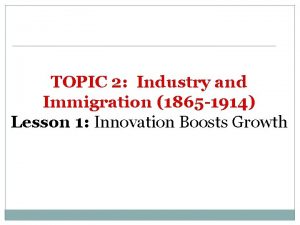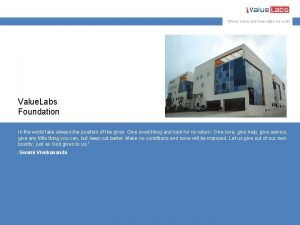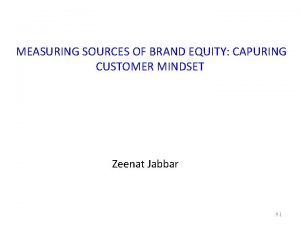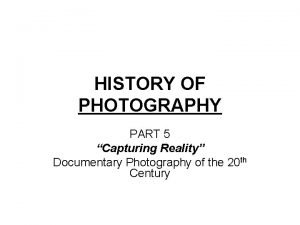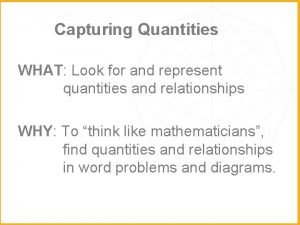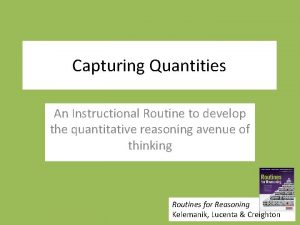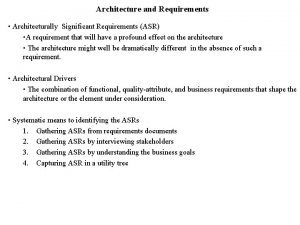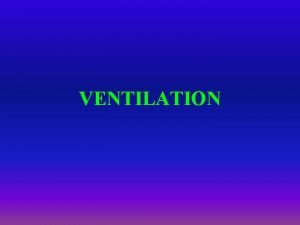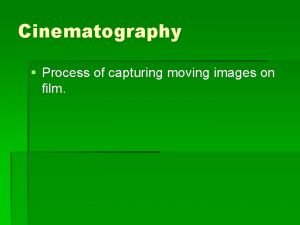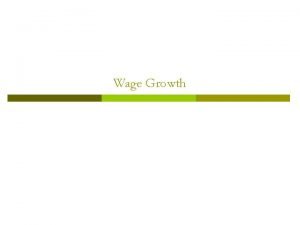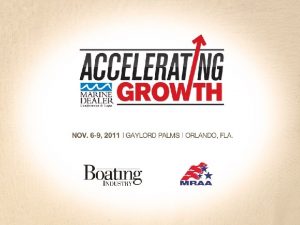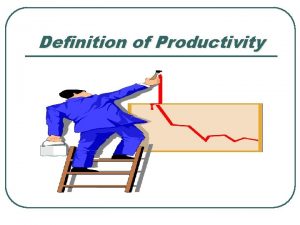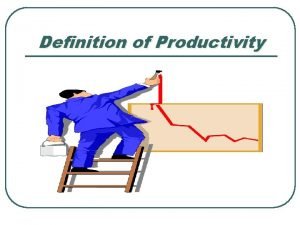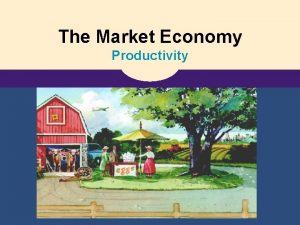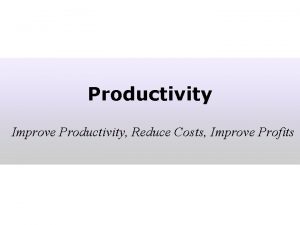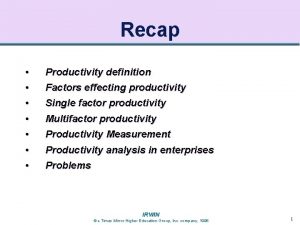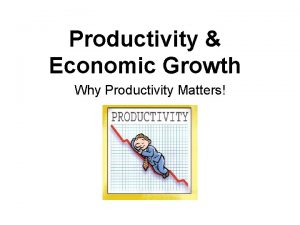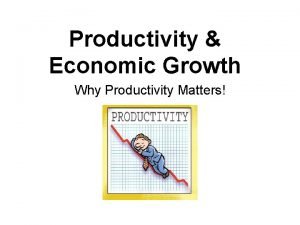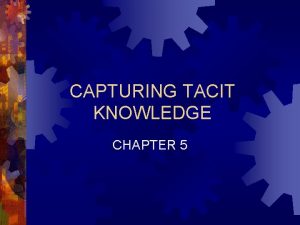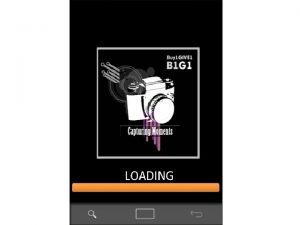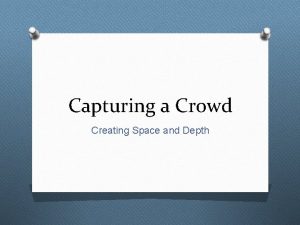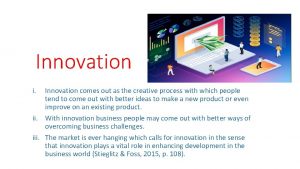Capturing Value for Growth Productivity performers innovation comes





































- Slides: 37

Capturing Value for Growth

Productivity performers: innovation comes out on top Two years ago, having watched their competitiveness crumble through no fault of their own, Australia's business people began the Kubler-Ross "Five Stages of Grief": Denial, Anger, Bargaining, Depression, and finally… Acceptance. Business models are being reassessed and those that do not work well are being adjusted. These sectors are becoming leaner and meaner. In this way, the high AUD may be helping to fix Australia's weak productivity problem. RBA deputy governor Philip Lowe says productivity growth improved in 2012 (2/3/2013)


3 Types of Innovation 1. Product 2. Process 3. Business Model

Aspects of Business Innovation to create value Improving efficiencies through QA, LEAN and other process improvements plus New Technology & Design Applications that are innovative and change people’s behaviours Innovation enablers that resource change Access to financial resources, new warehousing or locational opportunities, new skilled staff or competencies, better deployment of capabilities and resources Innovation that captures value Focusing on effectiveness innovations and business model processes to capture value that is under-utilized, unassigned, or not value priced

Value Chains Core Competencies Those capabilities, resources, opportunities, personnel, locational advantages etc that give your business advantage when optimised. They: Make it difficult for competitors to imitate Can be reused for multiple products and markets, and Contribute to the customers experienced end benefit. Value Chain Management Derives from realisation that no company operates independently, they operate in systems or chains of value that can be continually and appreciably improved, invariably by working closer with others

Comparative Differences in Value Chain Structure A B C 1. Transactional Value Chain AB C 2. Cooperative Value Chain A B C 3. Coordinated Value Chain A C B 4. Collaborative Value Chain Management (VCM) - the processes businesses use to manage their own operations and influence the operations of others in their value chain. VCM is a reiterative process that takes time, resources and skill.

Driven by mutual self interest • Requires high levels of commitment on all sides • Creates new value • Value accrues to all parties Requires specialisation & commitment of time on each sides. Requires surrender of self to a higher ideal. Value might accrue to one part or neither Co-operation Meets a need; often driven by a directive Can succeed even if commitment is uneven Value often incremental Co-ordination Driven by directive Teamwork helps but not pivotal Value unlikely to accrue to all involved Often focused on one-time, shortterm goals Most often one-off Transactional Driven by the need to exchange Goods and services exchanged Value limited to the price Collaboration Requires high levels of personal trust Only requires medium levels of personal trust Personal trust not a key to success Trust in the exchange rather than the person What is collaboration? Adapted by Frank Wyatt from Economist Intelligence Unit

Business Model Innovation The discipline of finding new ways of creating, delivering and capturing value by modifying the structures, activities and relationships of the business Identifies market segments and defines the customer Articulates the value of the proposed offering Focuses on the key attributes of the offering Defining the value chain to deliver more services with the offering Creates not only a way to get paid, but a way to get paid twice Appropriates the value of the proposed products and services Establishes a value network that is needed to make the model self sustaining

Business Model Innovation When and Why? • Underpin the business planning process • Identifying under-utilised market segments and better defining customer needs • Create a deeper understanding of plans with collaborators, partners and suppliers • Provide a clear picture of a planned business to investors or internal stakeholders • Creates new ways to get paid twice • Develop business cases for market entry • Optimise the value obtainable for a given business concept • Assist in evaluating alignment with organisational strategy

Competition between business models The competition of today is between business models, not just products or solutions. 11 Fuji. Film Vs Kodak Skype Vs Telstra Ryan. Air Vs QANTAS Toner Vs Printer

Focus of Innovation Effort

Calculated rate of return on the different innovation types Source: Helin, K. and J. Lehtonen “VOITTO: About Business Plan and Innovation”, Presentation

Productivity = Efficiency + Effectiveness Resources, cash, technology, work sequencing, design, products & services = outcomes Efficiency H Innovation, solutions, convergent technologies, customer experience, organisation, collaboration & networking value = impact L H Effectiveness

Business Model Innovation is about transforming key elements of your business or inventing completely new ways of doing business How d oy your c ou profile ustom e What rs? demog raphic s? What customers or needs have you ignored so far? HINDSIGHT What do you know about your customers? INSIGHT How does this enable you to get closer to their needs? FORESIGHT How might this inform what you will need next? What products, processes or business model for the future ?

THREE QUESTIONS WHY HOW WHAT Simon Sinek, http: //www. startwithwhy. com/

INTRODUCTIONS EXERCISE: At the table where you are sitting introduce yourself to those around you not by the WHAT, nor the HOW, but WHY? Do not answer with “to make a profit” as this is a result not a reason. Why do you do what you do? Make the answer customer centric!!

Business Model Innovation Customer Knowledge A business model is the recipe of your business built around an in-depth customer / consumer knowledge and insight of their needs “Last year one million quarter inch drills were sold. Not because people wanted quarter inch drills but because they wanted quarter inch holes. ” President of Black & Decker “What we sell is the ability of a 43 -year-old accountant to dress in black leather, ride through small towns and have people be afraid of him. ” Harley-Davidson marketing executive

Optional revenue logics • Customer focus – traveller • Scale = purchasing discounts • Joint promotion of cheaper carrier (Jet. Star) • Operational excellence + safety gives customer loyalty • Brand association linked to nationalism – customer loyalty • Customer focus – airports • Reverse auctioning of landing rights – positive cash flow • Operational excellence – low operating costs • Listing fees for all on board goods – positive cash flow Revenue logic: Build traveller loyalty + alternative cheaper carrier Revenue logic: Profit sharing with the airport + hybrid customer model What other customer segments have you not thought of? How else could you deliver your capabilities & offerings?

Business Model Innovation: Appropriating value Assuming you owned a chain of restaurants where global sales were sliding south rapidly, how would you double your turnover within 6 months? What assets and capabilities do you have to resource the change? What business model innovations could you apply?

Appropriating value: Mc. Café Ecology of existing & potential customer Utilise existing assets – chain of restaurants – new store layout and atmosphere Re-branded to Mc. Café Linked to the family and environmental concerns (Rainforest Alliance) Capture more customers at breakfast time and won them over from coffee chains to its lower-priced drinks (cheaper than Starbucks) Linking generational expectations – coffee and cake with Big. Mac people linger longer and buy more New revenues from old assets

Options for appropriating value You are producing romantic pocket books for teenage females and younger middle age females with lower levels of education You are distributing through bookshops etc. Your price to the consumer is $1 Your distribution channel keeps 50% Your author gets 20% Your operating costs are 25% This leaves you with 5% in profit contribution [or $0. 05] How do you quadruple the profit contribution without increasing the price?

Appropriating value – Mills & Boon Get into the customer eco-system – what do we know about the customer? What the customer wants? People who wanted to write, who wanted to talk about writing, and publish their writings The Radio play eco-system The TV series eco-system The Advertisement eco-system The E-Distribution eco-system for books The Mobile pay-as-you-go entertainment eco-system The Peer-to-peer publishing eco-system The Education eco-system The Product placement eco-system The Gaming eco-system The Bundled product eco-system

Options for capturing value Imagine you want to make $750, 000 in 30 hours with a new music album EXERCISE How would you go about it without a record company? You are not bothered by licensing so you use creative commons license? How would you connect with your fans to create a reason to buy?

Appropriating value – Nine Inch Nails NIN Rigorously connected to fans C 2 Fs + Rt. B = Business Model = $$$$s Ghost I IV Album 1 st Album Created numerous options for interaction between the fans Free download of 9 tracks by inserting your email address $5 got you full 36 tracks + 46 page PDF file on the band music = cheaper than i. Tunes $75 for the deluxe box with DVD, Blue Ray, and other cool stuff $300 Ultra Deluxe pack, only 2, 500 personally signed packs = this sold out in 30 hours = $750, 000 Issued under Creative Commons License, encouraged fans to remix it, share it, post it to blogs, play on podcasts, give it away…. . Amazon lists it as the highest selling album for 3 years running The Slip 2 nd Album Totally free album download – HQ MP 3 with live Google maps of where it was being downloaded and live networks to join to engage with others + embedded tickets to purchase online for the next concert – 5, 000 fans/concert @ $70/head = $375, 000 x 3 concerts = $1, 125 m

Converting your business model Your in the leisure and entertainment business Industry has been dominated by 3 to 5 national companies Your customer base has been largely restricted to children and parents Competition in your market is furious with multiple new entrants using new technologies and different offerings Margins have collapsed as cost increased How do you convert your business model to quadruple your returns?

Business Model Traditional circus Core elements - tent, clowns, animals & trainers, and acrobatic acts Star performers One show repeated, unrelated acts Children are principle customers supported by parents Animal acts are the main feature supported by clowns and gymnastics Emphasis on fun / Thrills Cirque Du Soleil Core elements - tent, clowns and the acrobatic acts No star performers No expensive animal acts & trainers Multiple productions, theme based Launch shows based on unique themes, soundtrack, costumes and sets Emphasis on Artistry Adults rather than children Cirque's 'one of a kind' shows resemble theatrics and ballet performances

Cirque Du Soleil Revenue Logic 1. New, more profitable segment of customers willingness to pay: Price increase 1. Multiple Productions: more visits per customer Revenue Generation 2. Increased value for customers the Industry Higher Volumes Pulls New Customers into 3. Eliminated costs yearly productions, faster turn around Leveraging higher value

Learning from other industries You’re a small textile manufacturer – one of the few that survived the GFC from the sector You produce low-margin fabrics highly moisture absorbent Specialised fabric can sell for ONLY 20 c a square metre Factory is a model of efficiency with all product produced to order and shipped the day it is made Company is non-unionised with 50 staff rewarded for performance with a share of 10% of company profit Realise that niche is small thinking, think big like other successful manufacturers How do you reposition to produce higher returns and ensure sustainability of your business?

Options for Textor High innovation ecology - CSIRO scientists working with the company to increase understanding of man-made fibres High tech equipment increased turnover by 72% & reduced labour costs as a percentage of sales by 26 per cent Only take orders of millions of square metres at a time Use the high A$ value to buy equipment NOW Effectively turned their textile plant into a process engineering plant – learnt from petrochemical and power industries “Labour cost is not the problem. The problem is, your business model has to make sense in a global world” Phil Butler, CEO Textor

Re-focusing Value Positioning Value derived from the appreciation of the offering Value derived from the possession of the offering Value derived from the deployment of the offering © Copyright Göran Roos 2011 Instrumental value Intrinsic value Extrinsic value

Instrumental (Contractor) Extrinsic (End User) Intrinsic (Specifier)

Exercise: Apply this thinking to two businesses at your tables and consider how they might shift the value up towards Extrinsic Value

Clipping the Ticket Front – End Services Consulting Business Problem Solving Product Design Back-End Services Supplier Management Production & System Integration Product Delivery Installation & Commissioning Product Life Cycle On-site Management Asset Manage ment Product Sales & Operations Where in this value chain are you not clipping the ticket? What are your options for appropriating value? Process Outsourcing

Clipping the ticket Exercise: Where in your production process are you not clipping the ticket? Take two companies at your table and propose options for how they may appropriate value currently unassigned or not value priced?

These are examples of Business Model Innovation There is NO silver bullet!! You must build your own innovation into your business model

Thank you
 Creating value and capturing value
Creating value and capturing value Value innovation the strategic logic of high growth
Value innovation the strategic logic of high growth Capturing value from customers
Capturing value from customers Pricing: understanding and capturing customer value
Pricing: understanding and capturing customer value Marketing concept
Marketing concept Core customer and marketplace concepts
Core customer and marketplace concepts Innovation for the sake of innovation
Innovation for the sake of innovation Radical innovation vs disruptive innovation
Radical innovation vs disruptive innovation Characteristics of a skilled performance
Characteristics of a skilled performance First comes love, then comes marriage
First comes love, then comes marriage Value creation value delivery value capture
Value creation value delivery value capture Topic 2 industry and immigration
Topic 2 industry and immigration Value innovation labs
Value innovation labs Plant growth definition
Plant growth definition Monocots vs eudicots
Monocots vs eudicots Carothers equation
Carothers equation Primary growth and secondary growth in plants
Primary growth and secondary growth in plants Chapter 35 plant structure growth and development
Chapter 35 plant structure growth and development Geometric growth vs exponential growth
Geometric growth vs exponential growth Neoclassical growth theory vs. endogenous growth theory
Neoclassical growth theory vs. endogenous growth theory Difference between organic and inorganic growth
Difference between organic and inorganic growth Capturing kids hearts four questions
Capturing kids hearts four questions Capturing marketing insights
Capturing marketing insights Qualitative research techniques to measure brand equity
Qualitative research techniques to measure brand equity Capturing kids hearts excel
Capturing kids hearts excel Image capturing devices
Image capturing devices Capturing reality documentary
Capturing reality documentary Capturing customer mindset
Capturing customer mindset Capturing quantities
Capturing quantities Capturing quantities
Capturing quantities Example of data capturing
Example of data capturing Architecture significant requirements
Architecture significant requirements Capturing quantities
Capturing quantities Lev system design
Lev system design The process of capturing moving images on film
The process of capturing moving images on film Research data lifecycle
Research data lifecycle Marketing information system kotler
Marketing information system kotler Danone
Danone

